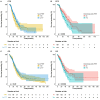Peptide Receptor Radionuclide Therapy and clinical associations with renal and hematological toxicities and survival in patients with neuroendocrine tumors: an analysis from two U.S. medical centers
- PMID: 39488644
- PMCID: PMC11531437
- DOI: 10.1007/s00432-024-06020-w
Peptide Receptor Radionuclide Therapy and clinical associations with renal and hematological toxicities and survival in patients with neuroendocrine tumors: an analysis from two U.S. medical centers
Abstract
Purpose: Renal and hematological toxicity are side effects and dose-limiting factors of Peptide Receptor Radionuclide Therapy (PRRT). We aimed to assess the changes in renal and hematological function and associations with survival in neuroendocrine tumor (NET) patients treated with PRRT.
Methods: A retrospective cohort of 448 NET patients treated with either 177Lu-DOTATATE or 90Y-DOTATOC were followed for changes of renal and hematological function. Renal function was assessed by monitoring changes in serum creatinine, blood urea nitrogen and estimated glomerular filtration rate. Hematological function was determined by examining changes in white blood cell counts (WBC), platelet counts, and hemoglobin levels over time. Piecewise linear mixed effect models were applied to model the longitudinal repeated measurements of renal and hematological function. Overall survival (OS) and progression-free survival (PFS) were modelled using Cox proportional hazard regressions.
Results: Of the 448 PRRT treated patients, 335 received 177Lu-DOTATATE (74.78%) and 113 were treated with 90Y-DOTATOC (25.22%). Comparing patients treated with 177Lu-DOTATATE to those treated with 90Y-DOTATOC, renal function did not differ significantly prior to, during or after PRRT. Compared with patients treated with 90Y-DOTATOC, significantly decreased indicators of hematological function were observed in those treated with 177Lu-DOTATATE prior to and during PRRT treatment (WBC: estimate, -0.10, 95% CI, -0.15 to -0.05; P < 0.001; platelet count: estimate, -2.53, 95% CI, -3.83 to -1.24; P < 0.001), and no significant recovery was observed in hematological function post PRRT. Individuals who received 177Lu-DOTATATE tended to have a longer PFS (hazard ratio, 0.47, 95%CI: 0.28-0.79, P = 0.004) compared with 90Y-DOTATOC, but there was no difference in OS.
Conclusion: There was no significant renal, but minor hematological toxicity, in patients treated with 177Lu-DOTATATE compared with 90Y-DOTATOC. Compared to 90Y-DOTATOC, 177Lu-DOTATATE appears to enhance PFS, but not OS. Treatment with 177Lu-DOTATATE may necessitate follow-up for hematological toxicity irrespective of other therapies prior to PRRT.
Keywords: Hematological toxicity; Neuroendocrine tumors; Peptide Receptor Radionuclide Therapy; Renal toxicity; Survival.
© 2024. The Author(s).
Conflict of interest statement
The authors declare no competing interests.
Figures
References
-
- Bodei L, Ferone D, Grana CM, Cremonesi M, Signore A, Dierckx RA, Paganelli G (2009) Peptide receptor therapies in neuroendocrine tumors. J Endocrinol Invest 32(4):360–369 - PubMed
-
- Bodei L, Cremonesi M, Grana CM, Fazio N, Iodice S, Baio SM, Bartolomei M, Lombardo D, Ferrari ME, Sansovini M, Chinol M, Paganelli G (2011) Peptide receptor radionuclide therapy with ¹⁷⁷Lu-DOTATATE: the IEO phase I-II study. Eur J Nucl Med Mol Imaging 38(12):2125–2135 - PubMed
-
- Bodei L, Mueller-Brand J, Baum RP, Pavel ME, Hörsch D, O’Dorisio MS, O’Dorisio TM, Howe JR, Cremonesi M, Kwekkeboom DJ, Zaknun JJ (2013) The joint IAEA, EANM, and SNMMI practical guidance on peptide receptor radionuclide therapy (PRRNT) in neuroendocrine tumours. Eur J Nucl Med Mol Imaging 40(5):800–816 - PMC - PubMed
Publication types
MeSH terms
Substances
LinkOut - more resources
Full Text Sources
Miscellaneous


